
Calamus is a genus of flowering plants in the palm family Arecaceae that is one of several genera known as rattan palms. There are an estimated 400 species in this genus, all native to tropical and subtropical Asia, Africa, and Australia.

Mitrephora is a genus of flowering plants in the family Annonaceae, that are native to an area that extends from China in the north to Queensland. Plants in the genus Mitrephora are also found in southern India and Southeast Asia.
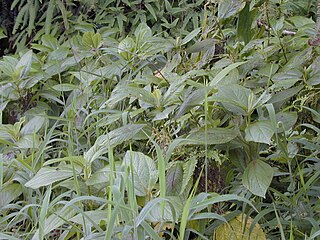
Boehmeria is a genus of 47 species of flowering plants in the nettle family Urticaceae. Of the species, 33 are indigenous to the Old World and 14 to the New World; no species is indigenous to both the Old and New Worlds. The species include herbaceous perennials, shrubs and small trees. Although related to the similar-looking species of the stinging nettles of genus Urtica, species of Boehmeria do not have stinging hairs. Because of the similarity in appearance, some species are commonly called "false nettles".

Baccaurea is a genus of flowering plants belonging to the family Phyllanthaceae. The genus comprises 51 species, distributed from India to Indochina, southern China, Malesia, New Guinea, and the West Pacific. It is dioecious, with male and female flowers on separate plants. Many species contain edible fruits.

Sterculia is a genus of flowering plants in the mallow family, Malvaceae: subfamily Sterculioideae. Members of the genus are colloquially known as tropical chestnuts. Sterculia may be monoecious or dioecious, and its flowers unisexual or bisexual.
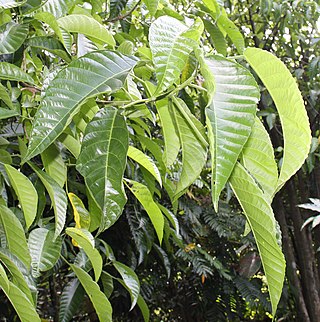
Dendrocnide is a genus of approximately 40 species of plants in the nettle family Urticaceae. They have a wide distribution across North East India, Southeast Asia, Australia and the Pacific Islands]. In Australia they are commonly known as stinging trees.
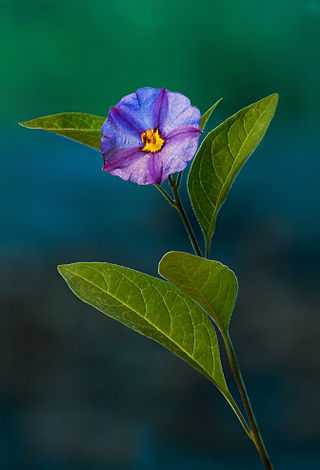
Lycianthes is a genus of plants from the nightshade family (Solanaceae), found in both the Old World and the New World, but predominantly in the latter. It contains over 150 species, mostly from tropical America, with 35-40 species in Asia and the Pacific.

Glycosmis is a genus of flowering plants in the citrus family, Rutaceae and tribe Clauseneae. It is in the subfamily Aurantioideae, which also includes genus Citrus. It is a genus of the subtribe Clauseninae, which are known technically as the remote citroid fruit trees.

Laportea is a genus of plants in the family Urticaceae. They are herbaceous, either annual or perennial. Like many plants of the Urticaceae, they have stinging hairs. There are stinging and non-stinging hairs on the same plant. The genus was named after the French naturalist Francis de Laporte de Castelnau.

Urophyllum is a genus of flowering plant in the family Rubiaceae, native to from south China to Tropical Asia. The genus was established by Nathaniel Wallich in 1824.
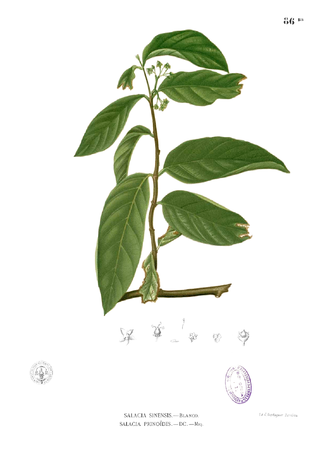
Salacia is a genus of plants in the family Celastraceae. They are woody climbers naturally found in tropical regions.

Argostemma is a genus of flowering plants in the family Rubiaceae. It can be found in (sub)tropical Asia and western and west-central tropical Africa.
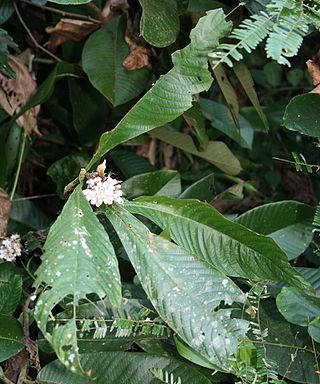
Mycetia is a genus of flowering plants in the family Rubiaceae. It includes 54 species, ranging from the Indian subcontinent through Indochina, southern China, and Malesia to New Guinea.
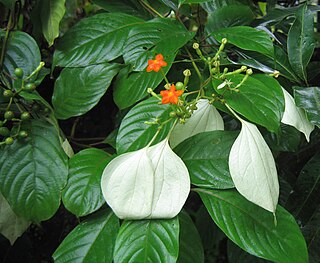
Mussaenda is a genus of flowering plants in the family Rubiaceae. They are native to the African and Asian tropics and subtropics. Several species are cultivated as ornamental plants.

Poikilospermum is a genus of shrubs or tall woody climbers, consisting of at least 33 accepted species. The plants are found from India and China (Yunnan), the Sino-Himalayan region to Sulawesi and Jawa in Indonesia. Some of the plants are used by people.
Maoutia is a genus of shrubs or small trees in the nettle family (Urticaceae).
Hypobathrum is a genus of flowering plants belonging to the family Rubiaceae.

Leucosyke is a genus of flowering plants belonging to the family Urticaceae.

Procris is a genus of flowering plants in the family Urticaceae. It includes 24 species native to tropical Africa, tropical Asia, New Guinea, and Queensland.

















